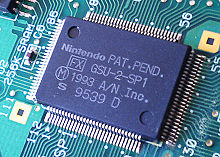Super FX
Super FX is the name of a coprocessor that was used as an additional chip in game modules for the Super Nintendo Entertainment System . It was developed by the British development studio Argonaut Software on behalf of Nintendo in order to increase the performance of the game console . The chip was a keystone in the development of 3D graphics for the rail shooter Star Fox .
description
The mathematical co-processor based on RISC technology was specialized to support the console in the calculation and display of shaded and textured 3D polygons by taking over the calculation work of the CPU. The computing power of the console could be increased by up to six times. The development took about three years. The original chip had a clock frequency of 10.4 MHz . Only shader loops of limited size are processed from an internal instruction memory at full speed; if the commands come from the ROM, the Super FX usually has to wait for the ROM.
Later two other versions appeared with the GSU-1 and the GSU-2 ( Super FX 2 ), both had a speed of 21.4 MHz. The GSU-2 could use mask ROMs larger than 8 Mbit (1 MB), a maximum of 16 Mbit (2 MB) were used.
Modules with the Super-FX-Chip had additional contacts in addition to the normal contact pins, which prevented the use of the modules in some NTSC- to- PAL converters or copier stations . In addition, modules were more expensive to manufacture because of the additional hardware installed. As a result, the retail price for games with Super FX support was higher than other games.
Emergence
The partnership between Nintendo and the British development studio Argonaut came about after Argonaut gave Nintendo a demo of a game with which the developer had succeeded in breaking the copy protection of the Game Boy portable console . Both companies entered into a business relationship. Nintendo was particularly interested in Argonaut's knowledge of 3D graphics and had the company conduct project studies on 3D games on the NES , the Game Boy and finally on the previously unpublished SNES. However, none of the consoles were designed with 3D graphics in mind and were therefore not powerful enough. Shigeru Miyamoto's team originally worked with an additional DSP chip for Pilotwings , but were dissatisfied with the performance. Argonaut offered to develop a chip themselves that would significantly increase the console's performance. The development of the chip was closely related to the development of the rail shooter Star Fox , which was largely programmed by Argonaut according to Nintendo's design specifications. The Super FX was a keystone that made the game's 3D polygon graphics possible. Argonaut hired hardware developers who previously worked at Konix , Sinclair Research and Flare Technology , including Ben Cheese, to develop chips. Part of the development team, the programmers Dylan Cuthbert, Giles Goddard and Krister Wombell, was quartered at the Nintendo headquarters. Argonaut first developed the software and then wrote a RISC instruction set that was tailored to the execution of the software. The Super FX is a scalar microprocessor with a multiplication unit, it is not a hardware rasterization unit.
Games with Super FX chip
Super FX with MARIO CHIP 1
The first super FX chip MARIO ("Mathematical, Argonaut, Rotation & Input / Output") was used in the 1993 game StarWing (known as StarFox in the USA and Japan). It was the only game with this chip clocked at 10.4 MHz.
Super FX with GSU-1
The second version of the Super FX in the GSU-1 variant with 21.4 MHz was used in four Super Nintendo games:
- Dirt Racer
- Dirt Trax FX
- Stunt Race FX
- Vortex
Super FX 2 with GSU-2
The clock frequency of the third version of the Super FX chip was identical to the second (21.4 MHz), but could use mask ROMs larger than 8 Mbit (1 MB).
Games with a Super FX GSU-2 are:
Unpublished games
Development was canceled for other Super FX games:
- Comanche
- FX fighter
- Power Slide SFX
- Star Fox 2
- Transformers
Individual evidence
- ↑ Brother Buzz: Super FX . In: GamePro (US) . No. 45, April 1993, p. 62.
- ↑ Born slippy: the making of Star Fox

